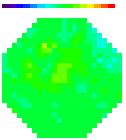|
Minimizing
Noise |
|
Dark Noise (NeuroPDA-II) The
place to begin is to examine the noise in the dark. This noise should
not be larger than a certain size and should have a flat FFT spectrum.
With the NeuroPDA system, measure the dark
noise with the following settings: 1.
Second stage
amplifier low-pass filter: 1 kHz; 2.
Second stage
amplifier high-pass filter: AC2 on; 3.
Use fastest
acquisition rate: 1.3 usec; 4.
Number of
points: 1024; 5.
First stage
gain: high; and 6.
Second stage
gain: 50. Determine the size of the dark-noise by measuring its RMS value under Output, determine its frequency content by using the FFT option under Trace. A flat spectrum with an absolute RMS value of less than 50 is good. Extraneous Dark Noise (NeuroPDA-II) There
are a number of recognized causes of a not-flat FFT; all of them can be
eliminated. A peak at 60 (50) Hz (or harmonics) indicates AC noise in
the system; 120 or 180 Hz may come from the room light; peaks around
200 - 300 Hz may come from acoustic noise (e.g. from the air handling
system); a peak near 1000 Hz may come from oscillation of the amplifier
system. Extraneous Light
Noise After
the extraneous dark noise is minimized, a second class of noise
sources, termed extraneous or technical noise, may be present after
illuminating the preparation. Again, there are a number of recognized
causes all of which can be eliminated. Fluctuations in the output of the light source: ·
Tungsten
filament lamps. It is not difficult to
provide a power supply stable enough so that the output of a tungsten
filament bulb fluctuates by less than 1 part in 105.
Tungsten filament sources are almost always used in absorption
measurements and are also preferable in those fluorescence measurements
where relatively large light intensities are obtained (i.e. a photocurrent > 10-8 amps). ·
Arc Lamps. In the past, intensity fluctuations were a problem with arc
lamps. Now, Opti-Quip, Inc., (www.optiquip.com, Highland Mills,
NY, 10930, (914) 928-2254) provides 150 and 250 watt power supplies,
lamp housings, and xenon arc lamps with noise that is in the range of 1
part in 104. We found that the 150 watt bulb yielded 2-3
times more light than a tungsten filament bulb (over the range 475-565
nm) and in turn the 250 watt bulb was 2-3 times brighter than the 150
watt bulb. The extra intensity was important for fluorescence
measurements from single neurons. Vibrational Noise Another
source of extraneous light noise is vibrations in the light path. This
noise tends to be in the frequency range of 1-50 Hz. ·
Shutters. The opening of a shutter attached to the microscope can
cause a very large vibration signal. We found that this noise damps out
over a period of about 1 second. Vibrations from the shutter can be
greatly reduced by mounting the shutter so that it is not touching the
microscope (i.e. on another platform that is vibrationally
isolated from the microscope). ·
Floor
Vibrations. A number of precautions for
reducing the effects of this vibrational source include eliminating
air-water interfaces, eliminating convection currents in the lamp
housing, filtering the saline to remove particles, and mounting the
apparatus on a platform made from two optical table-tops separated by
(and mounted on) air-filled rubber tubes (obtained from Newport:
isolator, air cushion, #5274). Embedding ganglia in 1-3% agar further
reduced vibrational noise. Minus K
Technology sells Biscuit bench top vibration isolation tables with
very low resonant frequencies. They provide outstanding vibration
isolation. Shot Noise When
all of the extraneous noises are reduced enough, the remaining noise
will either be dark noise (very low light intensity) or shot noise
(higher intensity). In the NeuroPDA
apparatus this crossover occurs at a resting light photocurrent of
about 5 x 10 -10 amps. In the NeuroCCD system
the Noise Pickup The
FastOne camera can pick up noise from
other electrical devices. In one instance, moving an arc lamp power
supply away from the camera and its power supply eliminated the noise. |
||||||||||||||||||||||||||||||||||||||||||||||||||||||||||||||||||||||||||||||||||||||||||||||||||||||||||||||||||||||||||||||||||||||||||||||||||||||||||||||||||||||||||||||||||||||||||||||||||||||||||||||||||||||||||||||||||||||||||||||||||||||||||||||||||||||||||||||

